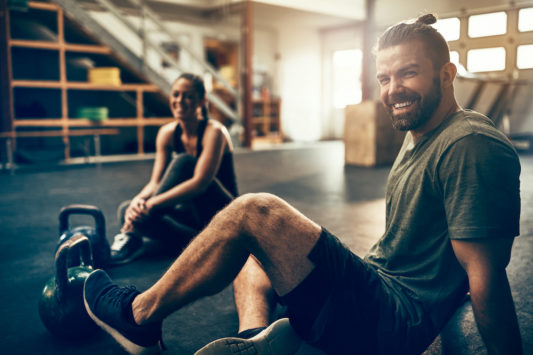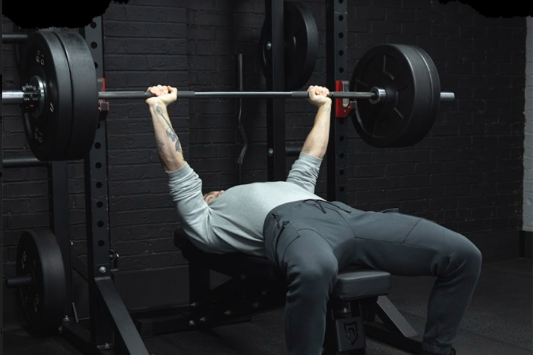Bench press muscles worked
The bench press had become iconic, synonymous with chest day and building the upper body. It’s fun, it’s popular and it’s effective. All you need to know that is to try and get hold of a flat bench in a busy gym – it’s a real mission.
But in terms of bench press muscles worked, is this limited only to the upper body? Although the chest is the primary muscle stimulated, others play an important part too. It’s a compound movement, after all.
Here we clarify the main muscles that bench press works, as well as the secondary ones you may not know about.

What are the main muscles that bench press works?
Pectoralis major
Otherwise one as the ‘chest’, the pectoralis major muscle originates from the sternum (breastbone), ribs, and clavicle (collar bone) and is attached to the upper part of the arm bone (humerus).
This is the main muscle the bench press works. On any good chest day, some variation of the bench press is usually done, whether it’s flat bench, incline or decline.
Anterior deltoid
The shoulders are made up of three heads: anterior (front), medial (middle) and posterior (back). The front head of the shoulder is worked in the bench press, along with many other push day exercises.
This often causes muscular imbalances, as many prioritise push movements over others. To get a rounded, well-balanced shoulder, you must also do movements that work the medial and posterior heads of the shoulders, such as lateral raises and rear delt flyes.
Triceps
Triceps are the muscles on the posterior portion of your upper arm. Although biceps tend to get most of the plaudits when it comes to arm size, triceps are two-thirds of your arms and are what give you that aesthetic thickness.
To clarify, here we’re talking about the primary muscles worked in a flat bench press here. But as the bench is a heavy compound, there are many other muscles it works, but to a lesser extent.

Secondary muscles that bench press works
- Core
- Latissimus dorsi
- Biceps brachii
- Forearm
- Quadriceps
- Medial & Posterior deltoid
- Glutes
- Hamstrings
- Gastrocnemius
Incline bench press muscles worked
Upper chest
It’s pretty common knowledge that the incline bench press (15°-45°) works the upper chest. But is it actually true?
With exercise alternates, it’s all about angle. Incline Bench is a perfect example of that. The inclined angle of the bench means that the primary stress on the pectorals is focused on the upper region, mainly because the position of the scapula is forced to move.
In a 2020 study by Int J Environ Res Public Health, they found that a 30° inclination produces greater activation of the upper portion of the pectoralis major. For inclinations above 30°, there is significantly greater activation of the anterior deltoid, which significantly decreases the EMG activity in the three portions of the pectoralis major.
Close-grip bench press muscles worked
Mid-chest, more triceps
The close-grip bench press primarily targets the triceps, with some involvement from the mid-chest muscles.
This exercise is especially beneficial for individuals aiming to increase their bench press one-repetition maximum (1RM) when the triceps are a limiting factor, or weakness for them. It assists in the final part of the movement, known as the lock-out.
Close-grip bench presses, along with dips, serve as excellent accessory exercises to strengthen this specific portion of the bench press movement.
Those shoulder injuries often opt for close-grip bench presses as an alternative to the full bench press, allowing you to keep your bench gains while recovering from injury. Very useful.
Decline bench press muscles worked
Lower chest
The decline bench press primarily targets the lower pectoral muscles, making it a good variation of the bench press. Despite being less popular compared to other variations, you find a decline bench in the gym empty. Lonely, some might say.
This might be because of another movement taking all the glory, which also gates the lower chest. Dips.
This killer bodyweight movement provides a similar stimulus to the decline bench press, meaning many individuals choose not to include decline in their training programme.
However, it’s worth testing this exercise if you haven’t done so before. You might like it, and if so, have a free bench every time you walk into the gym.
Dumbbell bench press muscles worked
Pectorals, anterior deltoid
The dumbbell bench press targets the pectoral muscles and the anterior deltoids, just like the standard bench press. However, the specific muscles emphasised during the exercise can vary depending on the bench angle chosen.
For example, an incline dumbbell bench press primarily targets the upper chest, while decline works the lower chest. The angle of the bench determines the muscle involvement.
What sets the dumbbell bench press apart is its increased difficulty. This is due to the additional challenge of stabilising the weights independently, which requires more effort from the supporting muscles.
A a result, you’ll be able lift less weight than you would with a barbell. Despite this, the dumbbell bench press is super effective in building strength and muscle mass and should be in every programme, whether flat or incline.

Frequently asked questions
Is the bench press good enough for the chest?
The bench press is a good exercise for developing the chest, but it shouldn’t be the only exercise you rely on.
While it is essential to include bench press in your program, incorporating other chest exercises is crucial to achieve a well-rounded chest and add variety to your routine. Here are some alternative push exercises you need to try:
- Dips
- Push-ups
- Cable press
- Chest press machines
- Pec deck
How does grip placement affect the muscles worked on the bench press?
The grip placement on the bench press significantly impacts which muscles are targeted. A narrower grip emphasises the triceps, while still engaging the chest muscles.
A wider grip reduces tricep involvement and places more emphasis on the chest. It also simplifies the lift due to the reduced range of motion. For this reason, powerlifters have the widest grip possible when attempting the heaviest lifts.
Finding your optimal grip width means comfort and stability, and achieving a position wider than shoulder-width but not excessively wide beyond a 90-degree angle. The right grip needs to feel natural.
Does the bench press work the triceps?
Yes, the bench press is effective for targeting the triceps. The triceps, along with the pectorals and anterior deltoids, are one of the primary muscle groups engaged during the bench press.
The close-grip bench press places greater emphasis on the triceps compared to the standard grip. This is due to its wider range of motion.
Combining big compounds like bench with isolation movements like cable pushdowns is an excellent way to make great gains on your triceps.
Does the bench press work the shoulders?
Yes, the bench press engages the anterior deltoids or the front of the shoulders as one of the primary muscle groups. The medial and posterior deltoids are also involved to a lesser extent.
Don’t rely on the bench to work your shoulder, though. Add specific shoulder targeting exercises into your programme.
Is the bench press bad for the shoulders?
No, the bench press is not inherently bad for the shoulders. However, poor form and incorrect bar path can increase the risk of shoulder injuries.
To avoid shoulder issues, it’s important to focus on proper form by tucking in your elbows, touching the barbell lower on the chest, and ensuring a controlled bar path. It’s about power and control.
The bar should start parallel to your shoulders and touch the bottom of your chest, following a curved-diagonal rather than a straight line. Strengthening your back muscles, particularly the latissimus dorsi and rear deltoids, also help prevent shoulder injuries.
Does the bench press work the biceps?
Although the bench press primarily targets the chest, it does involve the biceps to help stabilise the bar, particularly on the eccentric (down part of the movement).
However, the biceps are more effectively trained during pull days and back exercises like rows.
Does the bench press work the back?
The bench press indirectly engages the back muscles in an isometric manner, mainly the latissimus dorsi. These muscles serve as a solid foundation or counterweight during the lift. This is why retracting the scapula is an important part of any bench press setup.
However, it’s important to note that the back muscles are not actively extended during the bench press exercise. To properly target and strengthen the back, it is recommended to incorporate specific back exercises into your training routine on pull days.
Related articles to bench press muscles worked
Deadlift muscles worked
How to use wrist wraps
How to use lifting straps
What do knee sleeves do?
Best gym accessories
What does a weightlifting belt do?
Best leg day exercises












